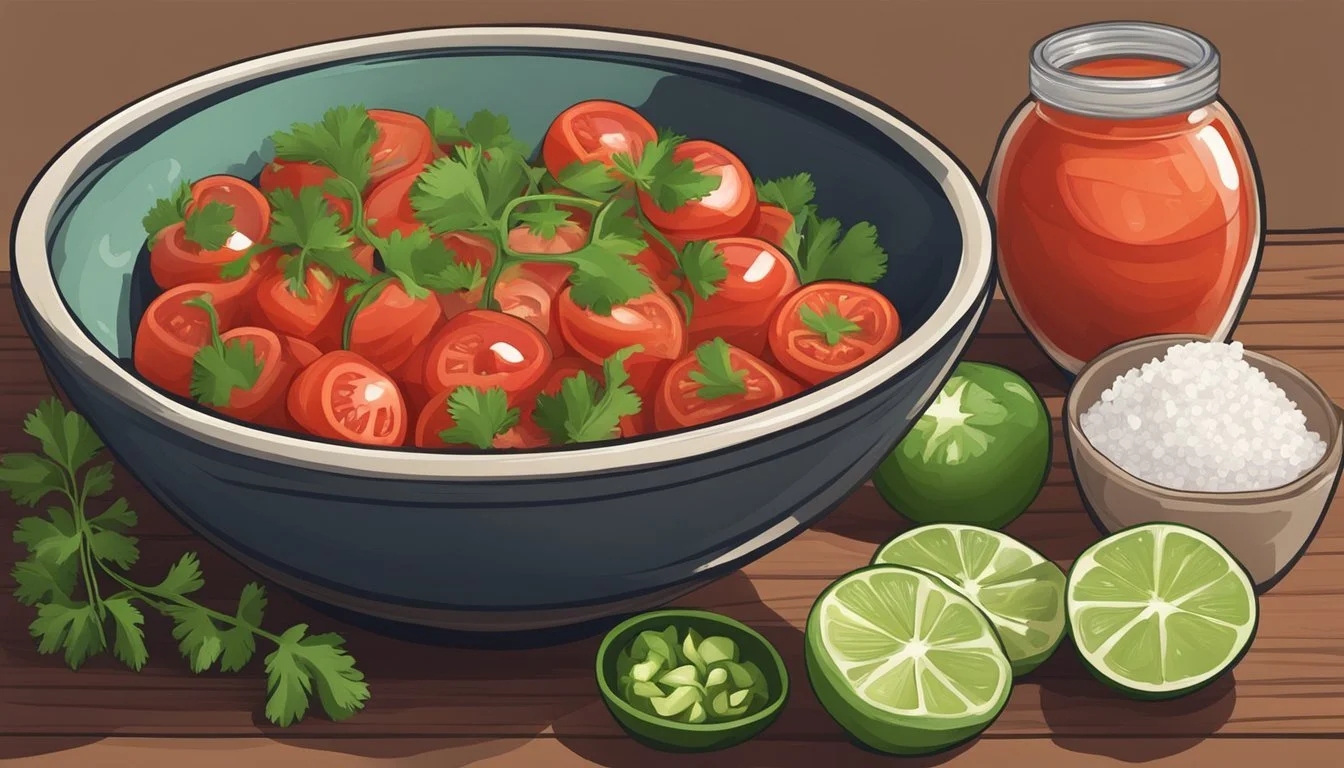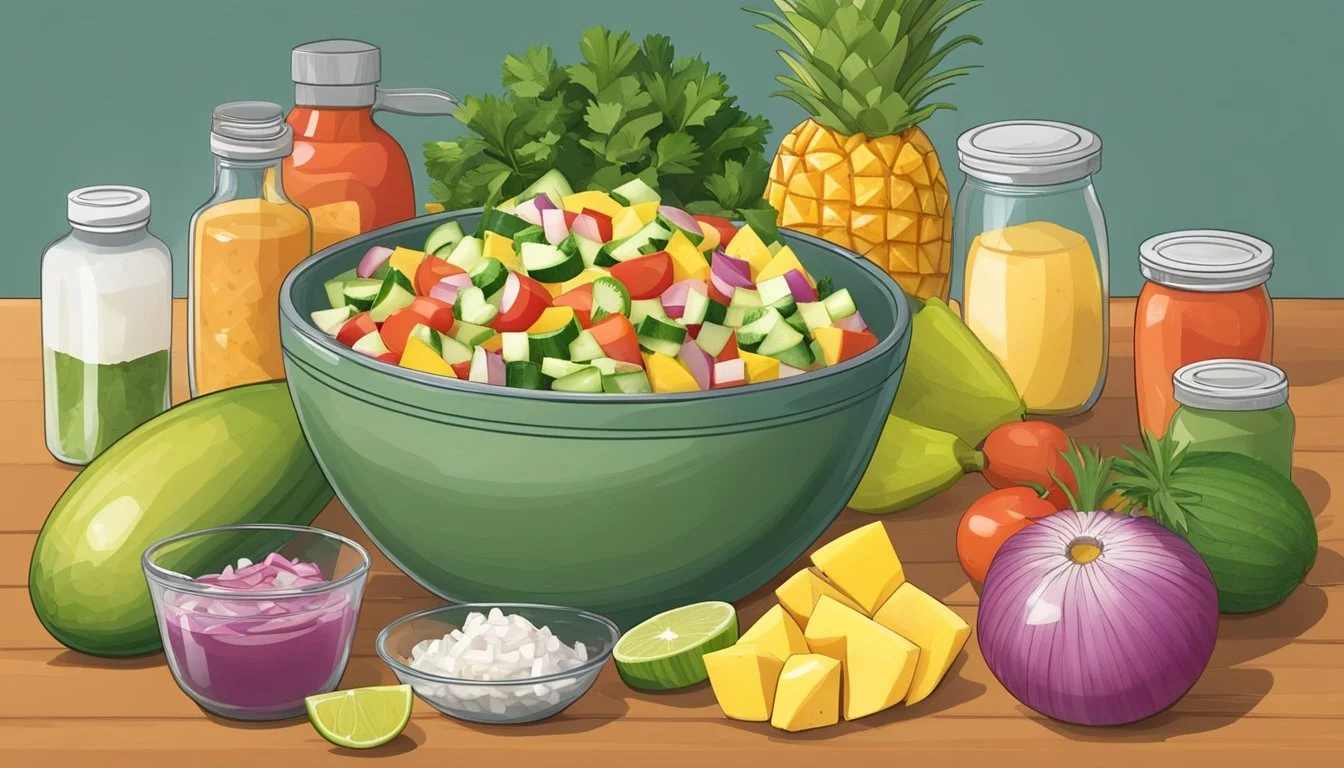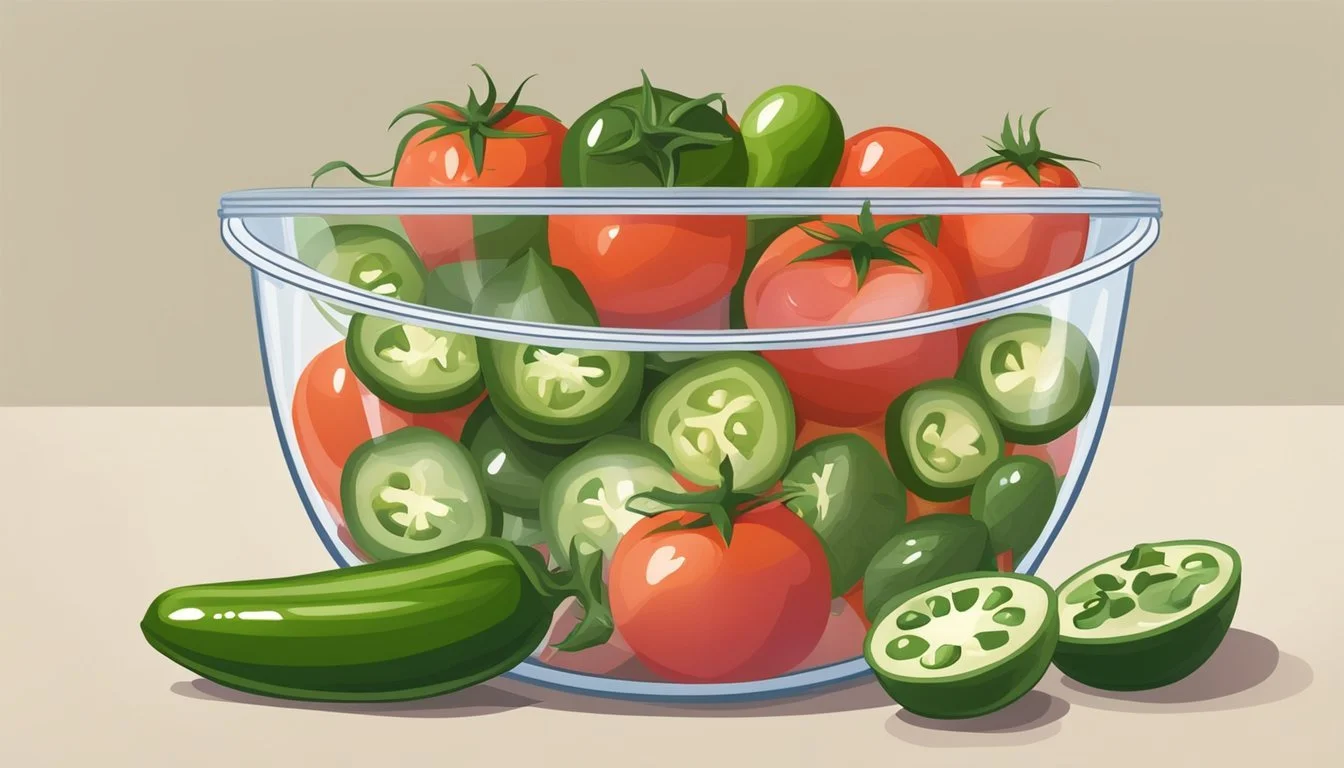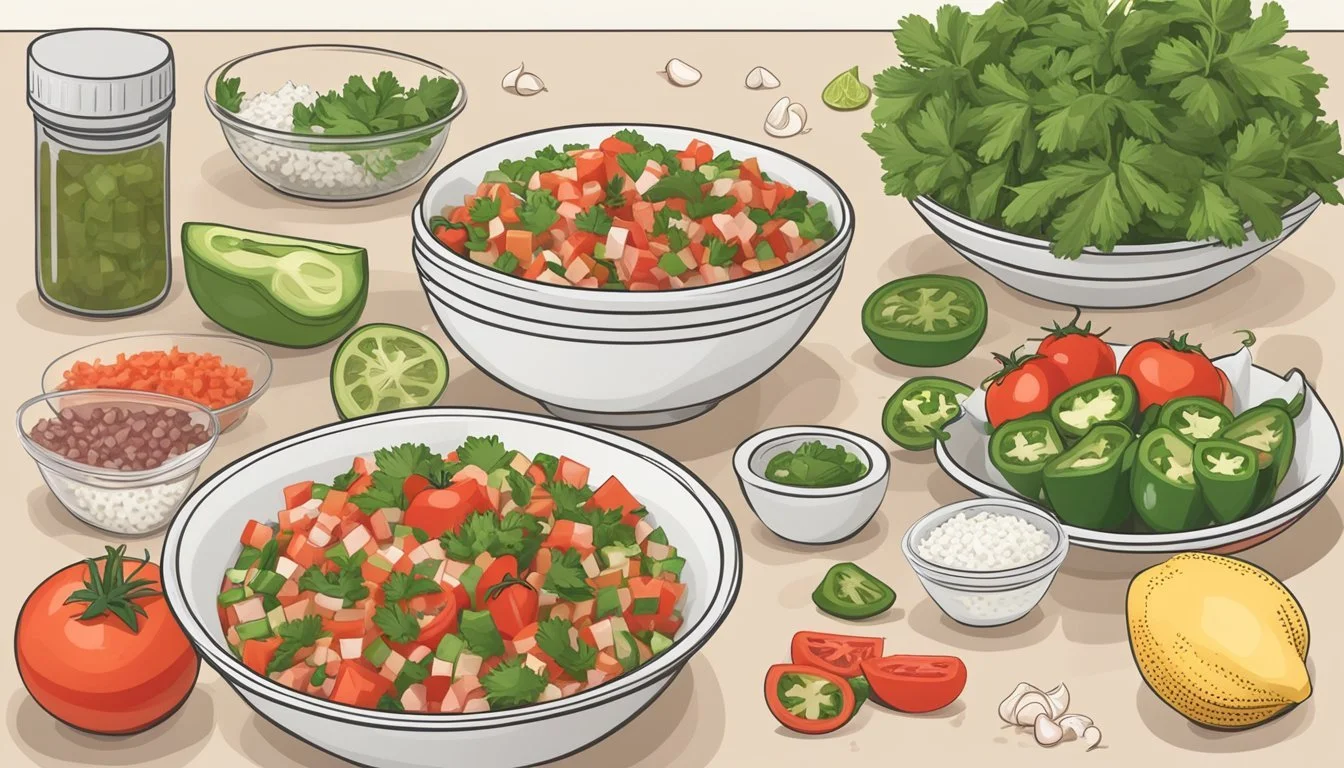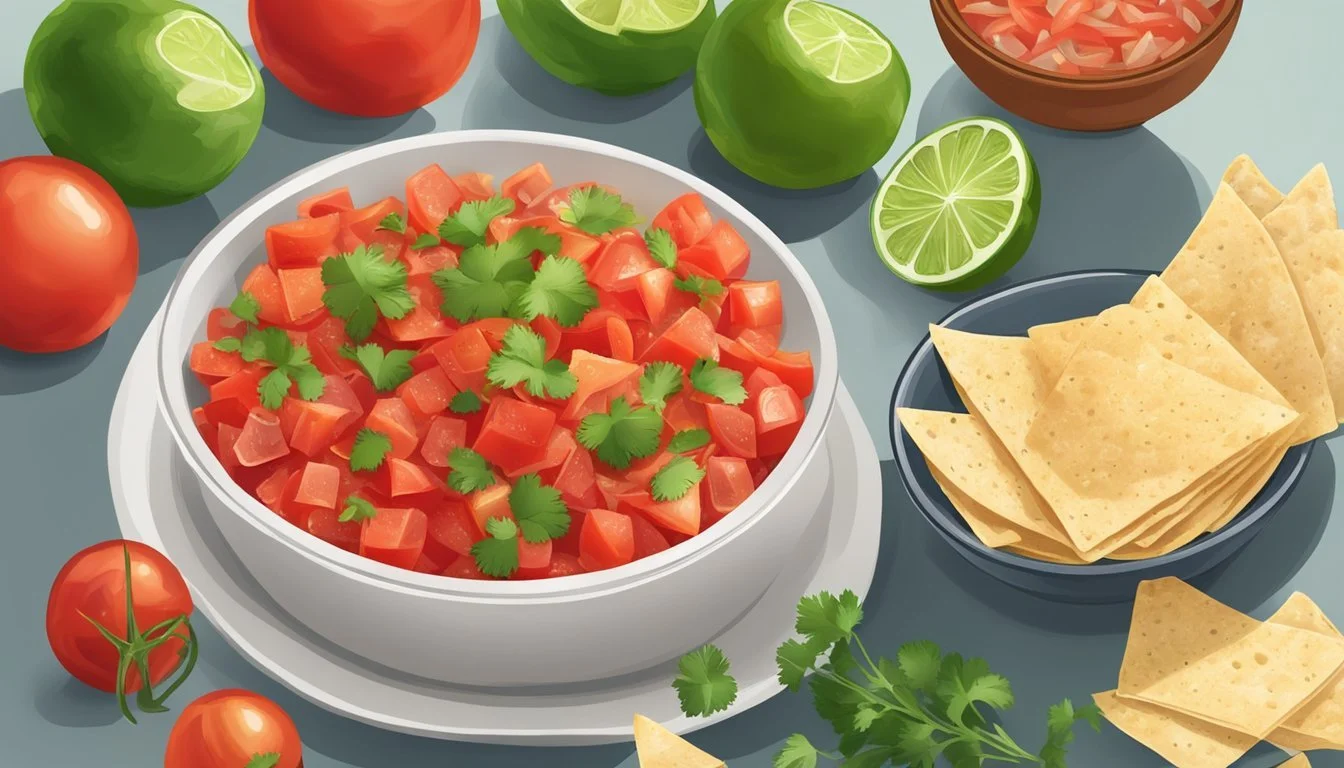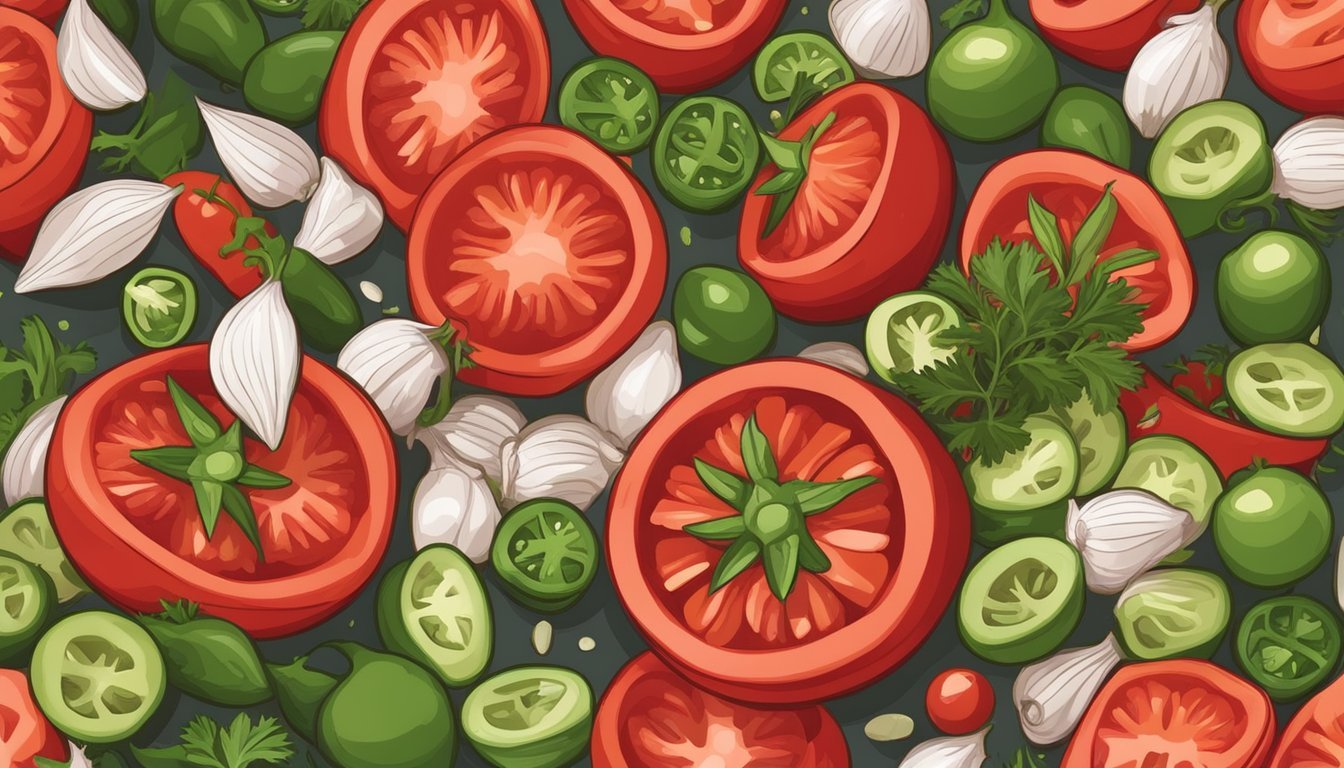Pico de Gallo Substitutes
Top Fresh Alternatives for Your Salsa Needs
Pico de gallo, also known as salsa fresca, is a staple in Mexican cuisine, renowned for its fresh taste and simple preparation. It consists of ripe tomatoes, crisp onions, fragrant cilantro, spicy chiles, and a splash of lime juice, with a balancing pinch of salt. This uncooked salsa celebrates the freshness of its ingredients, a tradition that sets it apart from other salsas, which may be cooked or may include a wider variety of ingredients and spices.
Finding substitutes for pico de gallo can be a challenge due to its distinct freshness and texture. The alternatives must honor the spirit of the original by emphasizing fresh, quality produce and maintaining a balance of flavors. Whether an individual is dealing with a shortage of certain ingredients or simply looking for a variation, the substitute should complement Mexican dishes with the same vibrant, crisp bite that pico de gallo provides.
When modifying the traditional recipe, one must carefully select ingredients that deliver similar brightness and zest. It is the combination of tangy, sweet, and savory notes that makes pico de gallo a beloved condiment, and much attention should be paid to replicate this harmony. Substitutes may not be identical, but they can still capture the essence of this Mexican classic while providing a novel twist to dishes.
Understanding Pico de Gallo
Pico de Gallo is a staple condiment in Mexican cuisine, distinguishable by its fresh, vibrant ingredients. This section will explore its traditional components and associated health benefits.
Traditional Components
Pico de Gallo, commonly known as salsa fresca or salsa cruda, typically consists of:
Tomatoes: The foundation, providing juiciness and sweetness.
Onion: Adds sharpness and crunch.
Cilantro: Contributes a distinctive, earthy flavor.
Lime Juice: Offers acidity, balancing the flavors.
Salt: Enhances overall taste.
The precise ratio of these ingredients can vary slightly by personal preference or traditional family recipes, but these five ingredients are always the core of Pico de Gallo.
Health Benefits
The raw components of Pico de Gallo bring several health advantages to the table:
Tomatoes: Rich in vitamin C and other antioxidants.
Onion: Provides fiber which aids in digestion.
Cilantro: Contains vitamins A and K, and is thought to have anti-inflammatory properties.
Lime Juice: Also high in vitamin C, crucial for repairing tissues and enhancing iron absorption.
Salt: Used sparingly, it completes the flavor profile without adding excessive sodium.
Nutrient-wise, Pico de Gallo is low in calories, sugar, and fat while providing a modest amount of protein and iron. It's a flavorful yet health-conscious addition to meals.
Reasons for Substituting Pico de Gallo Ingredients
In crafting Pico de Gallo, a traditional Mexican salsa, one might encounter various circumstances that necessitate ingredient substitutions. These can include personal health constraints, local produce availability, individual flavor preferences, or desired texture adjustments.
Dietary Restrictions
People with allergies may need to avoid certain ingredients typically found in Pico de Gallo. Ingredients such as onions and tomatoes could cause adverse reactions. For those with gluten sensitivities, it is important to ensure that any added condiments are gluten-free.
Availability Issues
The components of Pico de Gallo are often affected by seasonal availability. For instance, ripe, fresh tomatoes and cilantro may not be available year-round in some regions. Cooks might need to use canned tomatoes or substitute another leafy herb according to what is currently in season.
Flavor Preferences
Personal taste plays a significant role in ingredient substitution. Some individuals may find the sharp flavor of raw onions overpowering or might prefer a milder pepper to the traditional jalapeño. Adapting the recipe to suit these preferences can lead to a more enjoyable dining experience.
Texture Considerations
The desired texture is another reason for modifying Pico de Gallo recipes. If one prefers a smoother salsa, they might opt for fewer onions or blend the ingredients. Conversely, a chunkier texture could be achieved by coarsely chopping the vegetables instead of dicing them finely.
Substitute Ingredients Overview
Pico de gallo is a flexible dish that can be tailored to your taste or to accommodate the ingredients you have on hand. The following substitutes can be used without compromising the essence of this classic Mexican condiment.
Tomato Substitutes
In cases where roma tomatoes are unavailable, suitable alternatives include plum tomatoes, known for their sweetness and firmness, or cherry tomatoes, which are smaller but packed with flavor. When opting for cherry tomatoes, they should be chopped or diced to mimic the texture of the traditional pico de gallo.
Onion Varieties
The typical white onion can be substituted with other onion types for different flavor nuances. Red tomatoes offer a more vibrant appearance and a slightly milder taste. If a sweeter profile is desired, consider using sweet onions, ensuring they are finely chopped.
Cilantro Alternatives
For those who prefer a different herb or have a cilantro aversion, alternatives like Mexican oregano or flat-leaf parsley can serve as replacements. These should be used sparingly as they have distinct flavor profiles that can alter the taste significantly if overused.
Lime Juice Replacements
Traditional recipes prioritize fresh lime juice for its tangy zest. When limes are not available, lemon juice can be used. Another option is a ratio of grapefruit juice to water (1:3), considering the lower acidity of grapefruit. For the zip of lime without the juice, lime zest can also be incorporated.
Pepper Options
While jalapeños provide the characteristic heat, they can be replaced by serrano peppers for a hotter kick, or bell peppers for a milder version. When working with hot peppers, removing the seeds can reduce the heat level. Peppers should always be finely chopped to distribute their flavor evenly.
Preparing Substitute Mixes
When preparing substitute mixes for pico de gallo, it's essential to focus on replicating the fresh flavor profile and nutrition quality of the traditional recipe. Different ingredients and proportions can affect prep time, total time, and the servings one can expect from the substitute mix.
Making the Substitute Salsa
One begins by selecting fresh ingredients similar to those in traditional pico de gallo: tomatoes, onions, and peppers. For a quick and effective lime juice substitute, mix 1 tablespoon of kosher salt with 1 teaspoon of fresh lime zest. This provides the citrus note without the lime juice itself. The substitute's prep time will vary depending on the choice of ingredients but generally mirrors that of the original recipe.
Prep time: 10-15 minutes
Total time: Allow for at least 15 minutes after preparation for flavors to meld.
Servings: Approximately 2 cups
Adjusting the Flavor Profile
Adjusting the flavor is crucial when the ingredients change. If using grapefruit juice as a substitute, dilute it with water using a ratio of 1 part grapefruit juice to 3 parts water to match the desired acidity. For those omitting cilantro, vinegar can add the necessary tang. One must remember to adjust seasonings like salt and pepper to taste, as substitutes can alter the overall flavor balance.
Mild version: Less jalapeño, no chili powder
Bold version: Add extra garlic, more jalapeño, or spices like cumin
Balancing Nutrition and Taste
A substitute mix should aim to preserve the low-calorie and nutritious quality of pico de gallo. For example, grapefruit juice provides vitamin C but should be used sparingly to manage its influence on taste. It's key to ensure that the nutritional integrity remains high by using fresh ingredients and being cautious with added salts or sugars.
Calories: Comparable to traditional pico de gallo, varies with adjustments
Nutrition facts: High in vitamins A and C, low in fat
When crafting substitute mixes, one must respect the authenticity of the dish's roots while also accommodating individual dietary needs or ingredient availability. The success of a substitute mix is measured by its freshness, taste, and how well it complements the main dish just as the original would.
Alternative Pico de Gallo Styles
Exploring alternative styles to traditional Pico de Gallo offers a spectrum of flavors and textures perfect for pairing with numerous Mexican dishes. These variations retain the fresh, vibrant essence of Pico de Gallo while adding distinctive twists to complement different meals.
Salsa Varieties
Salsa Cruda, also known as salsa fresca, mirrors traditional Pico de Gallo but is often more blended, resulting in a saucier consistency. This style is suitable for spooning over tostadas or as a dip for nachos.
Another alternative is Tomato Salsa, which typically involves cooked ingredients and incorporates various spices and cooked tomatoes. This results in a deeper flavor profile ideal for topping enchiladas and burritos.
For a creamy twist, Guacamole incorporates ripe avocados with similar ingredients to Pico de Gallo, providing a richer texture perfect for quesadillas and tacos.
Global Influences
Global interpretations of Pico de Gallo infuse the classic recipe with international flair. For instance, one might add mango or pineapple for a sweet and tart note, aligning with tropical profiles. This type of salsa pairs wonderfully with seafood tacos or as an appetizer with tortilla chips.
Additionally, spicy Mexican Salsa can vary in heat levels and include a range of chilies. It can be used to bring a bold kick to nachos and tostadas.
Mole is a complex sauce that showcases the depth of Mexican cuisine and, while not a direct substitute for Pico de Gallo, it provides a unique flavor complement to enchiladas and burritos when a more savory, rich profile is desired.
Serving and Storage Tips
Pico de gallo is a vibrant condiment that enhances a variety of dishes, but to maintain its freshness and flavor, proper serving and storage are crucial.
Serving Suggestions
Dip: Serve pico de gallo as a dip with a bowl of crisp tortilla chips for a classic pairing.
Condiment: Spoon it over tacos, grilled meats, or fish to accent Mexican dishes with a burst of flavor.
Proper Storage Methods
Refrigeration: Always refrigerate pico de gallo in an airtight container to preserve its taste and prevent spoilage.
Duration: While fresh pico de gallo can be kept in the fridge for up to 4 days, it’s ideal to consume it within 1-2 days for the best quality.
Recipe Customization and Experimentation
Within the realm of preparing Pico de Gallo, personal preferences and creativity can lead to a range of delightful variations. Experimentation can yield uniquely flavorful salsas that complement a variety of dishes.
Creative Twists
To introduce a unique character to Pico de Gallo, one may integrate fruits such as mango, pineapple, or peaches. These fruits impart a sweet contrast to the traditional savory profile. For instance:
Mango: Diced mango can add a tropical sweetness that pairs well with the zesty lime and fresh cilantro.
Peaches: Slightly sweeter and softer than mango, peaches offer a tender texture.
Conversely, for those seeking a milder variation, cucumber can be included to add a crisp, refreshing dimension. It’s best to dice the cucumber finely to keep it in line with the other ingredients’ texture. A food processor can simplify the chopping process, especially when preparing larger batches, but it's important to pulse carefully to avoid overprocessing and losing the chunky consistency typical for Pico de Gallo.
Moreover, the introduction of avocado can create a creamier consistency and add a rich, buttery flavor. When the avocado is ripe, it easily meshes with the other ingredients, contributing to a more indulgent and cohesive experience.
Pico de Gallo in Cooking
Beyond its common role as a fresh salsa, Pico de Gallo's versatility extends to various cooking applications. Cooks can use it:
Cooked: Incorporating Pico de Gallo into a dish during the cooking process can infuse the meal with a bright, herbaceous flavor. It is well-suited for stirring into scrambled eggs or topping grilled fish.
Roasted: For a deeper flavor, roasting the Pico de Gallo ingredients before mixing can add a smoky element. Roasted vegetables like bell peppers and onions blend well, enhancing the complexity.
In both scenarios, the traditional freshness of Pico de Gallo transforms, catering to those who desire a more mellow flavor profile in their dishes. Whether it’s served fresh or used as a flavorful addition to cooked preparations, Pico de Gallo’s adaptability makes it an invaluable component in culinary experimentation.
Nutritional Information Per Serving
Pico de gallo, also known as salsa fresca, is a fresh, uncooked condiment made from chopped tomato, onion, cilantro, fresh chiles, salt, and lime juice. A typical serving size is about half a cup, which is approximately 100 grams.
Calories: A serving contains roughly 20-30 calories, making it a low-calorie addition to meals.
Macronutrients:
Protein: Minimal, about 0.5-1 gram per serving.
Carbs: Around 4-6 grams, primarily from the vegetables.
Fats: Negligible amounts of fat, typically less than 1 gram.
Fiber: Around 1-2 grams, contributing to satiety and digestion.
Vitamins and Minerals:
Vitamin C: A notable constituent due to the ingredients like tomatoes and lime juice.
Potassium: Present in moderate amounts, beneficial for blood pressure regulation.
Vitamin A: Found in smaller amounts from the tomatoes.
Calcium: Present, but in minor quantities.
Sodium: Varies based on the addition of salt but generally low.
Pico de gallo is an excellent choice for those looking to add flavor without significantly impacting their daily caloric intake. Its fresh ingredients provide valuable nutrients, making it not only a flavorful addition to meals but also a healthy one.
Conclusion
When seeking alternatives to authentic pico de gallo, one must consider the qualities that define this Mexican staple. Traditional pico de gallo is known for its freshness and vibrant flavors, which play a crucial role in complementing various Mexican dishes. Its preparation is deeply rooted in Mexican tradition, emphasizing the use of fresh, raw ingredients.
To maintain the integrity of Mexican cuisine, substitutes should be chosen to reflect the key attributes of the original condiment. The freshness can often be replicated by using other fresh salsas or uncooked relishes. Despite these changes, diners can still enjoy a quality experience when savoring Mexican dishes that typically feature pico de gallo.
Substitutes for Pico de Gallo:
Substitute: Fresh Salsa Variations
Pros: Incorporates a similar texture and acidity
Cons: May alter the traditional flavor profile
Substitute: Citrus Juices (Lime or Grapefruit)
Pros: Mimics the zest and tanginess
Cons: Can be either milder or sharper, adjust ratios accordingly
Those incorporating substitutes should consider adjusting the level of heat and seasoning to best emulate the balance found in traditional pico de gallo. It is advised that individuals taste-test during preparation to ensure that the end product complements the intended dish while respecting the culinary heritage of Mexico.
Additional Resources
For those who wish to explore further into the world of pico de gallo and its various ingredient alternatives, a plethora of resources are at one's disposal. They may consider the following:
Cookbooks: Specialized cookbooks focusing on Mexican cuisine often include sections on salsas and condiments, providing valuable insights into traditional and modern ingredient use.
Online Culinary Forums: Communities like Reddit’s r/Cooking or r/MexicanFood can be a treasure trove of information where home cooks and professionals alike share their experiences and tips.
Cooking Blogs: Dedicated food bloggers often experiment with recipes and may offer unique takes on classic dishes. Exploring these can yield creative substitution ideas and pairing suggestions.
Readers may find the following types of substitutions discussed across these resources:
Ingredient Common Substitutes Tomatoes Heirloom varieties, cherry tomatoes Onions Shallots, scallions Cilantro Parsley, Mexican oregano Lime Juice Lemon juice, vinegar Jalapeños Serrano peppers, bell peppers
For real-time discussions and advice, they may join cooking webinars or virtual cooking classes, which often cover a range of topics, including how to make the perfect pico de gallo with what's available in one's pantry.
Lastly, readers can utilize educational websites and databases that offer not only recipes but also the cultural background of dishes, such as pico de gallo, which may enhance understanding of when and how to use certain substitutes effectively.


